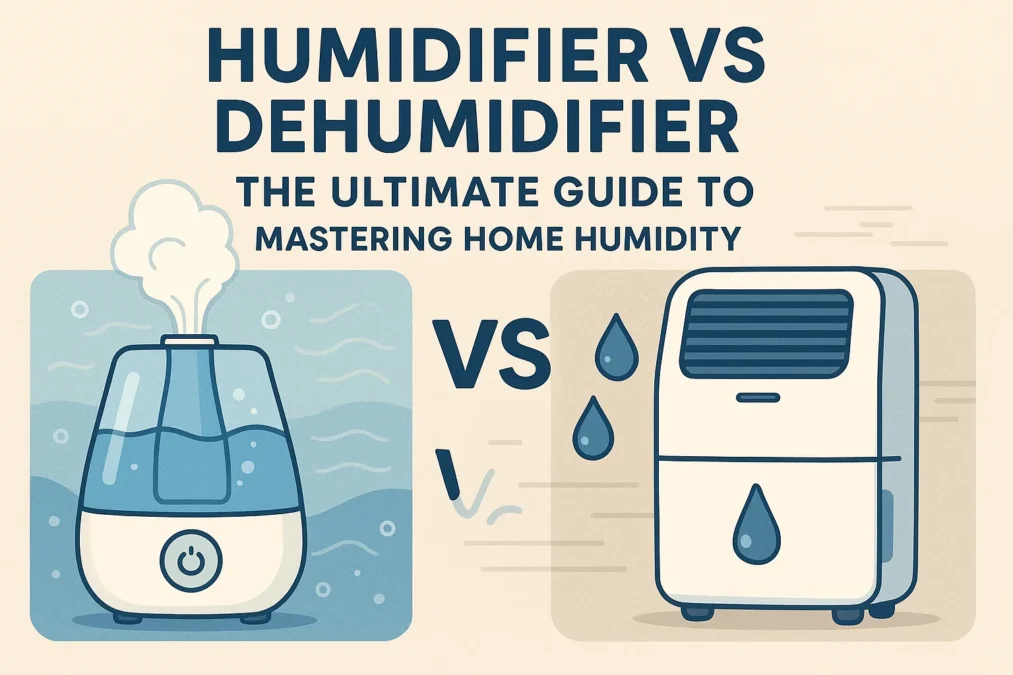Humidifier vs Dehumidifier: Walk into a room and it feels… off. Maybe the air is thick and heavy, making it difficult to breathe. Perhaps it’s so dry your skin feels tight and you wake up with a scratchy throat. In both scenarios, the invisible culprit is the same: the level of water vapor in your air, also known as humidity. Achieving the right balance is not just a matter of comfort; it’s a crucial component of your health, the well-being of your family, and even the preservation of your home and belongings. This is where two powerful appliances enter the picture: the humidifier and the dehumidifier. While their names sound similar, they perform diametrically opposite functions.
Understanding the fundamental difference between adding and removing moisture from your air is the key to transforming your living space. This comprehensive guide will dive deep into the world of humidifiers and dehumidifiers. We will explore how they work, the science behind humidity, the specific problems they solve, and how to determine which one—or if both—are necessary for your environment. By the end, you will be equipped with the knowledge to become the master of your indoor climate, creating a space that feels not just comfortable, but truly healthy and harmonious.
Understanding the Battle of Moisture: Adding vs. Removing
At its core, the comparison between a humidifier and a dehumidifier is a tale of two missions. A humidifier is a device designed to increase the humidity levels in a room or an entire house. It does this by releasing water vapor or steam into the air. Think of it as a gentle, continuous source of moisture for when your environment is too dry. It’s essentially giving the air a drink of water. On the other side of the ring, a dehumidifier is engineered to decrease humidity levels. It works by pulling in the surrounding air, cooling it to condense the water vapor, collecting that water in a tank, and then releasing the drier air back into the room. Its job is to act like a sponge, soaking up the excess moisture that makes the air feel damp and clammy.
The need for one or the other is dictated by your local climate, the season, and the specific conditions within your home. You would never use a humidifier in a damp, muggy basement, just as you wouldn’t run a dehumidifier in a dry, winter-heated bedroom where you’re suffering from nosebleeds. They are specialized tools for specific problems. Recognizing the symptoms of imbalance is the first step. Do your windows constantly have condensation? Do you see mold spots in the corners? That’s a cry for a dehumidifier. Are you getting constant static shocks from doorknobs? Is the wood in your floors or furniture cracking? That’s your home begging for a humidifier.
What is a Humidifier? Your Personal Oasis Creator
A humidifier is your go-to appliance for combating the discomforts of dry air. Dry air is most commonly a problem during the winter months when cold air, which holds less moisture, is heated by our furnaces and heating systems. This process of warming the air dramatically reduces its relative humidity, often to desert-like levels indoors. A humidifier counteracts this by introducing fine water particles into the atmosphere, raising the relative humidity to a more comfortable and healthy range. They come in various sizes, from small, portable units designed for a single bedroom to larger console units or even whole-house systems that integrate directly with your HVAC.
The benefits of using a humidifier are extensive. By restoring moisture to the air, it helps to soothe dry skin, lips, and nasal passages. This can be a significant relief for those suffering from allergies, asthma, or frequent sinus congestion. Adequate humidity can also reduce the survival rate of flu viruses in the air. Furthermore, from a practical standpoint, maintaining proper humidity helps protect wooden furniture, floors, and musical instruments from drying out and cracking, and it can even reduce static electricity that causes those annoying little shocks.
The Main Types of Humidifiers
When you decide you need a humidifier, you’ll encounter a few primary types, each with its own mechanism and ideal use case. The most common are evaporative humidifiers and ultrasonic humidifiers. Evaporative models use a fan to blow air through a moistened wick filter. The water evaporates, and the fan pushes that moisture into the air. These are generally self-regulating because as humidity increases, the rate of evaporation from the wick naturally slows down. They can be a bit noisier due to the fan, but they do not release white dust.
Ultrasonic humidifiers use a high-frequency ultrasonic vibration to create an extremely fine cool mist of water droplets. They are known for being very quiet and energy-efficient, making them excellent for nurseries and bedrooms. However, if you use hard water, they can produce a fine white mineral dust (calcium and lime) that settles on surfaces. Using distilled or demineralized water can prevent this. Other types include steam vaporizers (which boil water to create steam, but pose a burn risk) and impeller humidifiers (which use a rotating disk to fling water at a diffuser to create a cool mist).
Key Benefits of Using a Humidifier
The advantages of integrating a humidifier into your home when needed are both personal and structural. On the health front, adding moisture to dry air can provide immediate relief from chapped lips, dry throat, and itchy skin. It helps keep your respiratory system hydrated, which can lessen the severity of snoring, reduce coughing, and make it easier to breathe, especially at night. For children and adults prone to nosebleeds in dry weather, a humidifier can be a simple and effective solution.
Beyond the body, a humidifier plays a vital role in home preservation. Wood is a hygroscopic material, meaning it absorbs and releases moisture from its surroundings. In consistently dry conditions, wood floors can gap, furniture joints can loosen, and musical instruments like guitars and pianos can go out of tune or even crack. Paint and wallpaper can also peel more easily. By maintaining an ideal humidity level, you are protecting your investment in your home and possessions. Even your houseplants will thank you for it.
What is a Dehumidifier? Your Guardian Against Dampness
A dehumidifier is the solution for environments with too much moisture. High humidity is typically a problem in warmer climates, during the summer months, and in specific areas of a home like basements, crawl spaces, and bathrooms. These devices function similarly to air conditioners in that they cool air to condense its moisture, but unlike an AC, their primary goal is not to cool the room but to remove water. They are essential tools for preventing the myriad of problems that excess dampness can cause, from structural damage to health hazards.
The core mechanism involves a fan that draws warm, moist air over a set of cold coils (the evaporator). As the air cools, its moisture condenses on the coils, much like water droplets form on a cold glass of lemonade on a hot day. This water then drips down into a collection bucket or can be drained away via a hose. The now-dried air then passes over the warm condenser coils (which heat up as part of the refrigeration cycle) and is released back into the room at a slightly higher temperature but with a much lower humidity level. This continuous cycle gradually lowers the overall humidity in the space.
The Main Types of Dehumidifiers
The two most common types of dehumidifiers for residential use are refrigerant (or compressor) dehumidifiers and desiccant dehumidifiers. Refrigerant dehumidifiers are the most popular and work on the principle described above, using a compressor and coolant to create cold coils. They are highly effective in warm, humid conditions (typically above 60-65°F or 15-18°C) but become less efficient in cooler temperatures, as the coils can frost over.
Desiccant dehumidifiers, on the other hand, use a special hydrophilic material (the desiccant) to absorb moisture from the air. A fan passes air over a rotating wheel filled with this desiccant material, which soaks up the water vapor. Then, a separate heating element heats the wheel to drive the moisture out of it, which is then vented away, and the cycle repeats. These units are excellent for lower temperatures, such as in cold basements or during the winter, and are often quieter but can be less energy-efficient than refrigerant models in warm conditions.
Key Benefits of Using a Dehumidifier
The benefits of running a dehumidifier in a damp environment are profound. The most critical benefit is the inhibition of mold and mildew growth. Mold spores thrive in moist environments and can cause significant damage to walls, ceilings, and belongings, and pose serious health risks, including allergic reactions and respiratory issues. By keeping humidity low, you create an environment where mold cannot easily grow.
A dehumidifier also makes your space feel more comfortable. High humidity makes it difficult for your sweat to evaporate, which is your body’s natural cooling mechanism. This is why a 75°F (24°C) day can feel muggy and oppressive, while a 75°F day with low humidity feels pleasant and fresh. By removing excess moisture, a dehumidifier helps your body cool itself more effectively, making your home feel cooler and less sticky without necessarily lowering the thermostat. It also helps eliminate musty odors, protects clothing and fabrics from dampness, and deters dust mites, which also require high humidity to thrive.
The Great Humidity Showdown: A Side-by-Side Comparison
To truly grasp the difference between these two appliances, a direct comparison is invaluable. The following table lays out their core functions, ideal environments, and the problems they solve in a clear, concise format.
| Feature | Humidifier | Dehumidifier |
|---|---|---|
| Core Function | Adds moisture to the air (increases humidity). | Removes moisture from the air (decreases humidity). |
| Ideal For | Dry climates, winter months, and symptoms like dry skin/sinuses. | Humid climates, summer months, damp spaces like basements. |
| Symptoms It Solves | Dry skin & lips, static shock, cracked wood, frequent nosebleeds, sinus congestion. | Condensation on windows, musty odors, mold/mildew growth, a clammy feel, allergy flare-ups. |
| Common Types | Evaporative, Ultrasonic, Steam Vaporizer. | Refrigerant (Compressor), Desiccant. |
| Water Output | Emits visible mist or vapor into the air. | Collects water in an internal tank or through a drain hose. |
| Ideal Humidity Level | Used to raise levels to the ideal 30-50% range. | Used to lower levels to the ideal 30-50% range. |
| Maintenance Needs | Requires regular cleaning to prevent mold/bacteria in the unit and tank. Requires filter changes (evaporative). | Requires regular emptying of the water tank (unless drained continuously). Requires coil and air filter cleaning. |
How to Gauge Your Home’s Humidity Level
Before you run out and buy either appliance, it’s crucial to know what your home’s humidity level actually is. Guessing based on how you feel can be misleading. The most accurate and simple tool for this is a hygrometer. This is an inexpensive device, often available as a standalone unit or combined with a thermometer, that measures the relative humidity in the air as a percentage. Place one in the main living areas and another in any problem rooms, like a basement or bedroom, to get a clear picture of your home’s conditions.
So, what is the magic number? The Environmental Protection Agency (EPA) and most experts agree that the ideal relative humidity for a healthy and comfortable home is between 30% and 50%. When your hygrometer readings consistently fall below 30%, you are in the territory where a humidifier would be beneficial. If the readings are consistently above 50%, especially if they are climbing towards 60%, you have excess moisture that a dehumidifier can help control. Staying within this range prevents the problems associated with both extremes and creates the optimal environment for your health and your home.
9mm vs 40: The Definitive Guide to America’s Great Caliber Debate
Physical Signs of Humidity Imbalance
Even without a hygrometer, your home and body will give you clear signals. For low humidity, watch out for persistent static electricity shocks, frequent nosebleeds upon waking, dry and itchy skin or scalp, and increased sinus pressure. In your home, you might notice your wooden furniture or flooring starting to crack or separate, and plants may dry out very quickly.
For high humidity, the signs are often unmistakable. The most common one is condensation or fogging on the inside of your windows. You might notice a persistent musty or moldy smell, particularly in closets or basements. Visible black or green spots of mold on walls, ceilings, or around showers are a definite red flag. Clothes in closets may feel damp, and you might see water stains on walls or ceilings. All of these are urgent calls for a dehumidifier.
Making the Right Choice for Your Home
Choosing between a humidifier and a dehumidifier is not about which device is better; it’s about which one is right for your specific problem. Your local climate is the primary dictator. If you live in an arid region like the southwestern United States, or experience long, cold winters where indoor heating runs constantly, a humidifier will likely be your best friend for much of the year. It will combat the parched air created by your climate and heating system.
Conversely, if you live in a coastal area, a region with a humid subtropical climate, or a place with rainy seasons, a dehumidifier is almost a non-negotiable appliance, especially for managing basement moisture. Your home’s specific conditions are equally important. A basement or crawl space can be a source of dampness regardless of the climate above ground. In many cases, a household may need both. You might use a humidifier in the bedrooms during the dry winter and a dehumidifier in the basement year-round. It’s all about targeting the specific needs of each space.
Considering Room Size and Capacity
Once you’ve determined which appliance you need, selecting the right size and capacity is critical for effectiveness. For a humidifier, the key specification is the tank capacity and the room size it’s rated for. A small, personal humidifier with a one-gallon tank is perfect for a single bedroom or office. For a large living room or an open-plan area, you will need a console model with a larger output and tank capacity to avoid having to refill it constantly.
For a dehumidifier, capacity is measured in pints of water removed per 24 hours. A small 30-pint model might be sufficient for a moderately damp bedroom. A standard basement might require a 50-pint unit, while a very large, excessively damp space could need a 70-pint or larger commercial-grade dehumidifier. Buying an undersized unit will result in it running constantly without solving the problem, wasting energy and wearing out the appliance prematurely. An oversized humidifier can make a room feel wet and clampy, while an oversized dehumidifier could over-dry the air.
The Critical Role of Maintenance and Cleaning
Both humidifiers and dehumidifiers require consistent maintenance to function effectively and, more importantly, safely. A neglected humidifier can become a breeding ground for mold and bacteria, which it will then aerosolize and pump into the air you breathe, potentially causing respiratory illnesses. It’s essential to clean the tank and base regularly with white vinegar or another recommended cleaner, change the filters as directed, and never let stagnant water sit in the tank.
A dehumidifier also requires diligent upkeep. The collection bucket must be emptied frequently to prevent overflow and the growth of mold and slime inside the bucket itself. The air filter should be cleaned every few weeks to maintain airflow and efficiency. If your unit has a built-in pump or a continuous drain hose, you should still check it periodically for clogs. A dirty dehumidifier will not remove moisture effectively and can become a source of contaminants itself. Proper maintenance ensures you get the benefits without the downsides.
Beyond the Basics: Advanced Considerations
For those dealing with whole-home humidity issues, a standalone unit might not be enough. Whole-house humidifiers are installed directly into your forced-air furnace system. They add moisture to the air as it passes through your ductwork, ensuring consistent humidity levels throughout the entire home. Similarly, whole-house dehumidifiers are integrated into your HVAC system and can treat the air in your entire living space, often being more efficient and powerful than multiple portable units.
These systems represent a higher upfront cost but offer a seamless, low-maintenance solution. You don’t have to worry about filling tanks or emptying buckets. They are controlled by a central humidistat, much like your thermostat controls temperature, and they work automatically to maintain your desired setpoint. If you are building a new home or doing a major HVAC upgrade, these are worth serious consideration for achieving perfect, whole-home humidity control.
The Impact on Health and Allergies
The connection between humidity levels and health is direct and significant. For allergy and asthma sufferers, this balance is especially critical. When the air is too dry, it can irritate and inflame the respiratory tract, making you more susceptible to infections and triggering allergy and asthma symptoms. A humidifier can soothe these passages. However, if the air is too humid, it promotes the growth of dust mites and mold, two of the most common and potent allergens. A dehumidifier actively works to suppress these allergens.
Therefore, the goal is never to maximize or minimize humidity, but to optimize it. Staying within the 30-50% goldilocks zone is your best defense. It creates an environment that is comfortable for you but hostile to the biological pollutants that cause so much misery. It’s a powerful, non-pharmaceutical way to take control of your indoor air quality and support your family’s respiratory health year-round.
Energy Efficiency and Environmental Impact
Both appliances consume electricity, so considering their energy efficiency is good for your wallet and the planet. When shopping for a dehumidifier, look for the Energy Star label. An Energy Star certified dehumidifier uses about 15% less energy than a conventional model. For humidifiers, while there is no Energy Star rating, ultrasonic models are generally more energy-efficient than evaporative ones because they don’t require a powerful fan.
You can also use these appliances strategically to save on other energy costs. In the summer, using a dehumidifier to remove sticky moisture can allow you to set your air conditioner at a higher temperature while still feeling comfortable, saving on cooling costs. In the winter, properly humidified air feels warmer than dry air at the same temperature, allowing you to lower your thermostat slightly without sacrificing comfort, thereby saving on heating bills. It’s a smart way to leverage humidity control for overall energy savings.
Expert Insights and Final Recommendations
To summarize the importance of this balance, consider the words of an indoor air quality specialist: “Managing humidity is the single most overlooked yet impactful thing a homeowner can do for their property and health. It’s the foundation of good indoor air quality.” This sentiment echoes throughout the industry. The battle between a humidifier and a dehumidifier isn’t a conflict at all; it’s about applying the correct tool to achieve a state of equilibrium.
Your action plan should be simple. First, invest in a good hygrometer to diagnose the problem. Second, observe the physical symptoms in your home and your body. Third, based on your findings, select the appropriately sized appliance—a humidifier for dryness, a dehumidifier for dampness. Finally, commit to a regular cleaning schedule to ensure your device remains a source of comfort, not contamination. By taking these steps, you move from being a passive occupant to an active steward of your indoor environment, creating a home that is truly a sanctuary of comfort and well-being.
Frequently Asked Questions (FAQ)
What is the main difference between a humidifier and a dehumidifier?
The fundamental difference is straightforward: a humidifier adds moisture to the air to combat dryness, while a dehumidifier removes moisture from the air to combat dampness. They are designed to solve opposite problems. You use a humidifier when the air is too dry, typically in winter, and a dehumidifier when the air is too moist, typically in summer or in basements.
Can I use a humidifier and a dehumidifier in the same house?
Absolutely, and in many climates, it is highly recommended. It is common to use a dehumidifier in a damp basement year-round while using a humidifier in the living areas or bedrooms during the dry winter months. Humidity levels can vary significantly from one part of your home to another, so using both appliances in different areas to target specific needs is a practical and effective strategy for whole-home comfort.
What are the health risks of using a dirty humidifier or dehumidifier?
A dirty humidifier is a significant health risk. If not cleaned regularly, the stagnant water in the tank and the moist internal components can breed mold, bacteria, and other microorganisms. When the humidifier runs, it can then spray these contaminants into the air, which you can inhale, potentially leading to respiratory infections, flu-like symptoms, and worsened allergies or asthma. A dirty dehumidifier’s bucket can also harbor mold and bacteria, which can be released as musty odors and degrade your indoor air quality.
How do I know if I need a humidifier or a dehumidifier?
Start by checking your home’s relative humidity with a hygrometer. If it’s consistently below 30%, you likely need a humidifier. If it’s consistently above 50%, you need a dehumidifier. You can also look for physical signs. For a humidifier: static shock, dry skin/sinuses, and cracking wood. For a dehumidifier: condensation on windows, musty smells, and visible mold growth.
Where is the best place to put a dehumidifier or a humidifier?
Place a dehumidifier in the area where dampness is most prevalent, such as a basement, crawl space, or bathroom. Ensure it has clearance for air to circulate around it. Place a humidifier in the room where you spend the most time and are experiencing dryness, such as a bedroom or living room. Keep it on a flat, elevated surface away from walls and furniture to ensure the mist distributes evenly and to prevent moisture damage to surfaces.
Conclusion Humidifier vs Dehumidifier
The journey to understanding the humidifier vs dehumidifier dilemma ends with a simple but powerful realization: balance is everything. These two appliances are not rivals but partners in your quest for the perfect indoor environment. One adds what is missing, and the other removes what is excessive. By listening to the cues from your home and your body, and by using tools like a hygrometer to get the facts, you can make an informed decision that will significantly enhance your comfort, protect your health, and preserve your home. Whether you need the oasis-like relief of a humidifier or the dry, clean comfort of a dehumidifier, taking control of your humidity is one of the most impactful steps you can take toward a healthier, happier living space.



